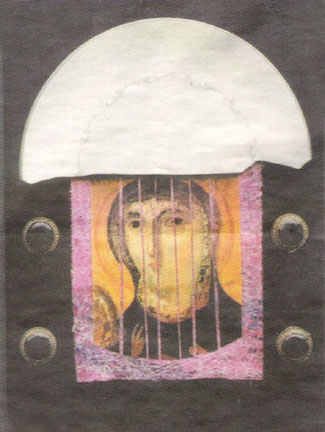
| Time scene |
 SEVEN
COLLAGE AND ASSEMBLAGE ARTISTS
SEVEN
COLLAGE AND ASSEMBLAGE ARTISTS TRANSFORM OBJECTS INTO ART AT THE
FIELDING GRADUATE INSTITUTE ART GALLERY
![]()
By Charles
Donelan
NEWS-PRESS CORRESPONDENT
![]() Seven
local artists have turned the gallery of the Fielding Graduate
Institute into the scene of a sprawling, ambitious inquiry into time
and space through the multiple mediums of collage and assemblage art.
The artists, invited by curator participant Wayne J. Hoffman, include
Tony Askew, Daniel Case, Steve Cushman, Anne Luther, Barbara McIntyre
and Susan Savage.
Seven
local artists have turned the gallery of the Fielding Graduate
Institute into the scene of a sprawling, ambitious inquiry into time
and space through the multiple mediums of collage and assemblage art.
The artists, invited by curator participant Wayne J. Hoffman, include
Tony Askew, Daniel Case, Steve Cushman, Anne Luther, Barbara McIntyre
and Susan Savage.
![]() More than 70 works are
now on view, ranging from the at once exuberant and wistful "54
Hared Ones" by Steve Cushman, with its central element of regulation
Rawlings baseballs, to the sensuous spiritual collages "Out of
the Ashes" and "The Narrow Gate" by Susan Savage, with
their delicate palettes and iconic tilted cross-structuring grids.
More than 70 works are
now on view, ranging from the at once exuberant and wistful "54
Hared Ones" by Steve Cushman, with its central element of regulation
Rawlings baseballs, to the sensuous spiritual collages "Out of
the Ashes" and "The Narrow Gate" by Susan Savage, with
their delicate palettes and iconic tilted cross-structuring grids.
![]() Curator Wayne J. Hoffman's
work is an anchor for the show, as Hoffman has a wide range, from the
Cornell-perfect balance of a cornucopia of small objects, as in "Sobrecarta,"
to the starkness of the portrait in "Israfel," scored as though
imprisoned and covered with a halo made of a half a broken dinner plate.
Curator Wayne J. Hoffman's
work is an anchor for the show, as Hoffman has a wide range, from the
Cornell-perfect balance of a cornucopia of small objects, as in "Sobrecarta,"
to the starkness of the portrait in "Israfel," scored as though
imprisoned and covered with a halo made of a half a broken dinner plate.
![]() Tony Askew is the pop
star of the group. He sings with primary colors and bold conversions
of the grid. Give him the wrapper from a pack of smokes, a bright yellow
envelope from the photo shop, some red and black ink, and a piece of
an old ruler, and he will, as in "Camel 3-9," hand you back
a postmodern composition of great visual appeal and intellectual depth.
Tony Askew is the pop
star of the group. He sings with primary colors and bold conversions
of the grid. Give him the wrapper from a pack of smokes, a bright yellow
envelope from the photo shop, some red and black ink, and a piece of
an old ruler, and he will, as in "Camel 3-9," hand you back
a postmodern composition of great visual appeal and intellectual depth.
![]()

![]() At
top, Anne Luther's "Lost World."
At
top, Anne Luther's "Lost World."
Above, Wayne J. Hoffman's "Israfel.
|